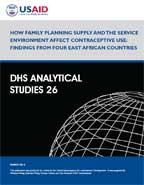- PUBLICATIONS
- JOURNAL ARTICLES
- ACCESS PUBLICATIONS
Publications Summary
- Document Type
- Analytical Studies
- Publication Topic(s)
- Family Planning
- Country(s)
- Kenya, Rwanda, Tanzania, Uganda
- Language
- English
- Recommended Citation
- Wang, Wenjuan, Shanxiao Wang, Thomas Pullum, and Paul Ametepi. 2012. How Family Planning Supply and the Service Environment Affect Contraceptive Use: Findings from Four East African Countries. DHS Analytical Studies No. 26. Calverton, Maryland, USA: ICF International.
- Download Citation
- RIS format / Text format / Endnote format
- Publication Date
- April 2012
- Publication ID
- AS26
Download
 How Family Planning Supply and the Service Environment Affect Contraceptive Use: Findings from Four East African Countries (PDF, 949K)
How Family Planning Supply and the Service Environment Affect Contraceptive Use: Findings from Four East African Countries (PDF, 949K)
